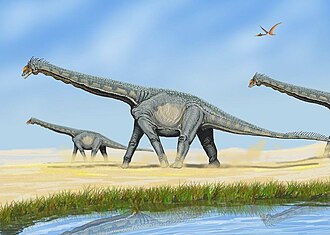Sauropoda






Sauropoda or sauropods are an infraorder of sauropterygian dinosaurs. They are well known for their enormous size, long necks, long tails, and four thick, pillar-like legs. They are one of the most recognizable groups of dinosaurs, with some members of the group including the largest animals to have ever lived on land. Sauropods first appeared in the late Triassic Period, about 210 million years ago, and became dominant by the Jurassic Period. They thrived until the end of the Cretaceous Period, around 66 million years ago, when they, along with most other dinosaur groups, went extinct during the Cretaceous–Paleogene extinction event.
Description[edit]
Sauropods were herbivorous (plant-eating), with long necks that allowed them to reach high and low vegetation. This adaptation, along with their peg-like teeth, was suited for their diet of leaves and other plant materials. They had small heads in comparison to their bodies, and their nostrils were located on the top of their heads. The body structure of sauropods was characterized by a massive torso, supported by four sturdy legs, and a long tail that could be used for balance or defense. Some species, like Diplodocus, had tails that were whip-like at the end, possibly used as a deterrent against predators.
Evolution and Diversity[edit]
The earliest known sauropods were relatively small, but the group rapidly evolved into the giant forms that are so well recognized today. Throughout the Mesozoic Era, sauropods diversified into a wide range of species. Notable genera include Brachiosaurus, Apatosaurus, and Brontosaurus. The diversity of sauropods is reflected in their varying body sizes, neck lengths, and feeding mechanisms. Despite their size, recent studies suggest that sauropods were capable of rearing up on their hind legs to reach higher vegetation, a behavior supported by the distribution of stress-bearing bones in their skeletons.
Habitat and Distribution[edit]
Sauropods were widespread and are found in fossil records on every continent, including Antarctica. They inhabited a variety of environments, from arid deserts to lush forests. The widespread distribution of sauropods indicates their ability to adapt to different environmental conditions and their diverse dietary strategies.
Extinction[edit]
The exact cause of the extinction of sauropods, along with the rest of the non-avian dinosaurs, is still a subject of research and debate. The prevailing theory is that a combination of climatic changes and the impact of a large asteroid or comet at the end of the Cretaceous period played a significant role in their extinction.
In Popular Culture[edit]
Sauropods have captured the public imagination and have been featured in numerous films, television shows, and books. They are often depicted as gentle giants, roaming the prehistoric landscapes in herds.

This article is a paleontology stub. You can help WikiMD by expanding it!
Ad. Transform your life with W8MD's Budget GLP-1 injections from $75


W8MD offers a medical weight loss program to lose weight in Philadelphia. Our physician-supervised medical weight loss provides:
- Weight loss injections in NYC (generic and brand names):
- Zepbound / Mounjaro, Wegovy / Ozempic, Saxenda
- Most insurances accepted or discounted self-pay rates. We will obtain insurance prior authorizations if needed.
- Generic GLP1 weight loss injections from $75 for the starting dose.
- Also offer prescription weight loss medications including Phentermine, Qsymia, Diethylpropion, Contrave etc.
NYC weight loss doctor appointmentsNYC weight loss doctor appointments
Start your NYC weight loss journey today at our NYC medical weight loss and Philadelphia medical weight loss clinics.
- Call 718-946-5500 to lose weight in NYC or for medical weight loss in Philadelphia 215-676-2334.
- Tags:NYC medical weight loss, Philadelphia lose weight Zepbound NYC, Budget GLP1 weight loss injections, Wegovy Philadelphia, Wegovy NYC, Philadelphia medical weight loss, Brookly weight loss and Wegovy NYC
|
WikiMD's Wellness Encyclopedia |
| Let Food Be Thy Medicine Medicine Thy Food - Hippocrates |
Medical Disclaimer: WikiMD is not a substitute for professional medical advice. The information on WikiMD is provided as an information resource only, may be incorrect, outdated or misleading, and is not to be used or relied on for any diagnostic or treatment purposes. Please consult your health care provider before making any healthcare decisions or for guidance about a specific medical condition. WikiMD expressly disclaims responsibility, and shall have no liability, for any damages, loss, injury, or liability whatsoever suffered as a result of your reliance on the information contained in this site. By visiting this site you agree to the foregoing terms and conditions, which may from time to time be changed or supplemented by WikiMD. If you do not agree to the foregoing terms and conditions, you should not enter or use this site. See full disclaimer.
Credits:Most images are courtesy of Wikimedia commons, and templates, categories Wikipedia, licensed under CC BY SA or similar.
Translate this page: - East Asian
中文,
日本,
한국어,
South Asian
हिन्दी,
தமிழ்,
తెలుగు,
Urdu,
ಕನ್ನಡ,
Southeast Asian
Indonesian,
Vietnamese,
Thai,
မြန်မာဘာသာ,
বাংলা
European
español,
Deutsch,
français,
Greek,
português do Brasil,
polski,
română,
русский,
Nederlands,
norsk,
svenska,
suomi,
Italian
Middle Eastern & African
عربى,
Turkish,
Persian,
Hebrew,
Afrikaans,
isiZulu,
Kiswahili,
Other
Bulgarian,
Hungarian,
Czech,
Swedish,
മലയാളം,
मराठी,
ਪੰਜਾਬੀ,
ગુજરાતી,
Portuguese,
Ukrainian